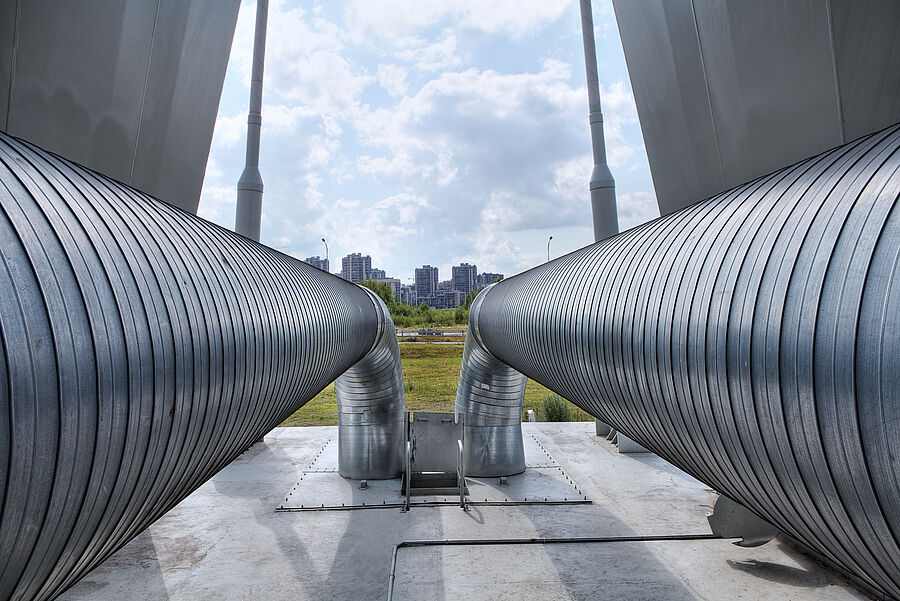Central component for sustainable energy systems
Thermal energy storage systems are a key component of sustainable energy systems. It offers the possibility of efficiently storing renewable energy in the form of heat and retrieving it when needed.
Importance of thermal energy storage in renewable energy systems
Flexibility and energy autonomy
Thermal energy storage systems increase the flexibility of energy systems by synchronising the supply of renewable energy with demand. They make it possible to temporarily store surplus energy from heat sources such as geothermal energy, industrial waste heat or solar thermal energy and utilise it at times of higher demand. This means that sources that are available all year round or only in summer can be utilised for the winter. They also enable the staggered use of surplus renewable electricity, for example from wind power or photovoltaics, in the form of cost-effective and climate-friendly heat, thus contributing to successful sector coupling.
Reduction of emissions
By storing heat, renewable sources can be better utilised and fossil fuels reduced or replaced. In combination with thermal networks such as district heating systems, thermal storage systems contribute to decarbonisation.
Cost savings
The utilisation of cheaply generated energy, such as continuously occurring waste heat but also night-time electricity, in combination with thermal storage leads to economic advantages. This decoupling of energy production and consumption can reduce system costs.
Innovative solutions for thermal energy storage
Our research in the field of thermal energy storage is characterised by a holistic approach that comprehensively integrates technical, economic and material aspects. From material and component development to the optimisation of entire systems, we take into account all relevant disciplines such as physics, mechanical engineering, process engineering, energy technology and geology.
This interdisciplinary approach allows us to combine innovative material technologies with optimised design and operating concepts. This enables us to maximise the efficiency of thermal storage solutions at all levels - from individual components to sector coupling.
Our main research areas:
- Material and component development and characterisation (à link to thermophysics)
- Experimental and simulation-based investigation and optimisation of components and overall systems
- Application-oriented conception, design and operational optimisation
- System integration under technical and energy management conditions
Our strength lies not only in our technological expertise, but also in the close link between research and practice. With the help of our integrated research infrastructure, which includes thermophysics laboratories, storage and geothermal laboratories as well as state-of-the-art simulation environments, we develop customised solutions for the challenges of the energy future.
This holistic perspective, combined with active collaboration in international expert networks such as the IEA Technology Collaboration Programme, ensures that our research is both technically sound and application-oriented. It provides the basis for sustainable and economically efficient energy storage systems that meet the requirements of the energy transition.
Types of thermal energy storage
Thermal stores can be divided into three main categories:
- Sensible heat storage: Heat is stored by changing the temperature of a medium such as water or rock.
- Latent heat storage: Energy is stored during a phase change, for example when materials melt.
- Thermochemical storage: Heat is stored in chemical reactions and released again when required by reversing the reaction.
Technologies for large-scale thermal energy storage
Tank thermal energy storage (TTES)
TTES systems store sensible heat in insulated tanks that are positioned above or below ground, usually with water as the storage medium. They are characterised by high energy efficiency and easy maintenance.
- Applications: Short-term heat storage in district heating networks, industrial plants, solar thermal systems.
- Advantages: High storage capacity and charging and discharging rates, low heat loss due to stratification (temperature profile of the storage medium due to density differences in the tank).
- Challenges: Limited size and high construction costs.
Pit thermal energy storage (PTES)
PTES systems store heat in (partially) insulated and sealed ground basins that are filled with water or water-gravel mixtures. This technology is particularly suitable for seasonal storage.
- Applications: Seasonal shifting of heat from summer to winter for large, thermal systems such as district heating networks (e.g. continuously generated heat from waste heat sources or geothermal energy, summer surpluses from solar thermal energy).
- Advantages: Medium to high storage capacity, cost-effective for large volumes, no size restrictions.
- Challenges: High space requirement, complex design and challenging maintenance and repair.
Aquifer thermal energy storage (ATES)
ATES systems store heat in sealed, groundwater-bearing rock layers (aquifers), which is stored and released in the form of water by means of wells.
- Applications: Seasonal shifting of heat from summer to winter (e.g. continuously occurring heat from waste heat sources or geothermal energy, summer surpluses from solar thermal energy).
- Advantages: Low, specific installation costs, large storage capacities possible, land surface remains usable.
- Challenges: Location dependency due to necessary geological conditions, high heat losses.
Borehole thermal energy storage (BTES)
BTES systems store heat in the rock underground. For charging and discharging, geothermal probes through which water flows are used to heat the surrounding soil.
- Applications: Seasonal heat storage for buildings (complexes) and larger systems.
- Advantages: Expandable, low construction costs.
- Challenges: High initial losses, geological requirements, low storage temperatures.
Cavern thermal energy storgae (CTES)
CTES systems store thermal energy in natural or artificial caverns, underground cavities in the rock. Water is used as the storage medium and the surrounding rock contributes to the thermal insulation.
- Application: Seasonal storage of large quantities of heat for thermal networks.
- Advantages: High storage densities and large storage capacities possible, land surface remains usable, long service life.
- Challenges: Geological conditions, limited potential in existing caverns, high construction costs for new facilities.
Applications of thermal energy storage systems
Integration into district heating systems
Large-scale thermal stores are an essential component of modern district heating systems. They enable the storage of waste heat from industrial processes or the demand-adapted utilisation of thermal energy that is available all year round, such as geothermal energy, as well as the shifting of solar energy for the winter months.
Real examples
- Dronninglund, Denmark (PTES): Utilisation of solar energy for seasonal heat storage.
- Vienna, Austria (ATES): Storage of waste heat and geothermal energy to cover heating requirements.
- Emmaboda, Sweden (BTES): Industrial waste heat is stored in a BTES system.
VECTES, Finland (CTES): Seasonal storage in the world's largest cavern storage facility for the district heating system of the city of Vantaa. https://interstores.eu/vectes/
Challenges and future developments
Technical and economic challenges
The biggest challenges include the high investment costs and lifetimes of the components, the space required and the dependence on location. Nevertheless, technological advances in materials science and design as well as intelligent integration into holistic energy systems offer great potential.
Future trends
- Intelligent design and control systems: Simulation-based optimisation of designs for system-compatible layout, integration of smart grids and smart operations for more efficient use.
- New materials: Advances in the development of materials and components lead to higher storage densities, longer lifetimes and better insulating properties.
- New storage concepts and combinations of storage technologies: Synergies between heat and cold storage, sensitive and latent storage and the use of existing infrastructures as thermal storage open up new storage options for optimised systems.
Large-scale thermal energy storage systems are indispensable for the realisation of the energy transition. They enable the reliable, cost-effective, sustainable and flexible utilisation of renewable energies. The further development of these technologies will further increase the realisation of necessary large-scale projects in the coming years.



